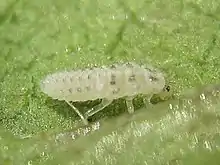| Psyllobora vigintimaculata | |
|---|---|
 | |
| Scientific classification | |
| Domain: | Eukaryota |
| Kingdom: | Animalia |
| Phylum: | Arthropoda |
| Class: | Insecta |
| Order: | Coleoptera |
| Infraorder: | Cucujiformia |
| Family: | Coccinellidae |
| Genus: | Psyllobora |
| Species: | P. vigintimaculata |
| Binomial name | |
| Psyllobora vigintimaculata (Say, 1824) | |
Psyllobora vigintimaculata, the twenty-spotted lady beetle, is a species of lady beetle in the family Coccinellidae.[1][2][3][4] It is found in North America.[1]
Appearance
P. vigintimaculata is about 1.75–3.0 mm in length and has four or five distinctive dark spots on the pronotum in an "M" shape. The elytra have dark, orange or bicolored spots on a white background. Although it is sometimes confused with the fourteen-spotted lady beetle (Propylea quatuordecimpunctata) and the Asian lady beetle (Harmonia axyridis), its unique pattern helps to distinguish it from other lady beetle species found in North America.[5]

Life cycle
In a laboratory setting, the subspecies P. vigintimaculata taedata undergoes four larval instars, molting and then pupation. The timing of life cycle varies according to rearing conditions.
Instars and pupation
The first instar larvae has a white oval body with small hairs projecting from the thorax. The larvae of the second instar have a stripe and a much darker color that gradually turns lighter with each subsequent instar. During the end of the fourth instar, the larvae attaches itself to a leaf or a petiole to molt. Pupae emerge with wing pads as well as black spots.
Duration
When eggs were deposited in 20°C it took about 32 days for adults to emerge. At 25°C it took about 20 days.[6]
Potential as biological control
It has been proposed that P. vigintimaculata could be used in place of fungicides as a biological control. This is because of its ability to utilize olfactory cues to seek out and feed on plants infected with powdery mildew, which is an agriculturally significant plant parasite.[7] This could help solve problems associated with current control methods like resistance, effect on non-target plants, and worker's safety. However, arthropod consumption of mildew and its potential for disease control is understudied. Some important considerations involve insect and mildew density, ability to locate food as well as seasonality of feeding.[6]
Parasitism
Hesperomyces virescens
The fungal parasite Hesperomyces virescens Thaxter has been reported to infect P. vigintimaculata.[8] More recent work has suggested that this parasite consists of multiple species, one per host,[9] though the species living on P. vigintimaculata has not yet been formally described. The level of harm that the parasite causes to its host is unclear.[10]
References
- 1 2 "Psyllobora vigintimaculata Report". Integrated Taxonomic Information System. Retrieved 2018-05-06.
- ↑ "Psyllobora vigintimaculata species details". Catalogue of Life. Retrieved 2018-05-06.
- ↑ "Psyllobora vigintimaculata". GBIF. Retrieved 2018-05-06.
- ↑ "Psyllobora vigintimaculata Species Information". BugGuide.net. Retrieved 2018-05-06.
- ↑ "Twenty-spotted Lady Beetle | Vermont Atlas of Life". val.vtecostudies.org. Retrieved 2021-12-06.
- 1 2 Sutherland, Parrella, Andrew, M (May 1, 2009). "Biology and Co-Occurrence of Psyllobora vigintimaculata taedata (Coleoptera: Coccinellidae) and Powdery Mildews in an Urban Landscape of California". Annals of the Entomological Society of America. 102 (3): 484–491. doi:10.1603/008.102.0319. S2CID 86165718.
{{cite journal}}: CS1 maint: multiple names: authors list (link) - ↑ Tabata, Jun; Moraes, Consuelo M. De; Mescher, Mark C. (2011-08-18). "Olfactory Cues from Plants Infected by Powdery Mildew Guide Foraging by a Mycophagous Ladybird Beetle". PLOS ONE. 6 (8): e23799. Bibcode:2011PLoSO...623799T. doi:10.1371/journal.pone.0023799. ISSN 1932-6203. PMC 3158101. PMID 21876772.
- ↑ Hardwood, Ricci, Romani, Pitz, Weir, Obrycki, James, Carlo, Roberto, Kevin, Alex, John (2006). "Prevalence and association of the laboulbenialean fungus Hesperomyces virescens (Laboulbeniales: Laboulbeniaceae) on coccinellid hosts (Coleoptera: Coccinellidae) in Kentucky, USA" (PDF). European Journal of Entomology. 103 – via Google Scholar.
{{cite journal}}: CS1 maint: multiple names: authors list (link) - ↑ Haelewaters, Danny; De Kesel, André; Pfister, Donald H. (2018). "Integrative taxonomy reveals hidden species within a common fungal parasite of ladybirds". Scientific Reports. 8 (1): 15966. Bibcode:2018NatSR...815966H. doi:10.1038/s41598-018-34319-5. ISSN 2045-2322. PMC 6206035. PMID 30374135.
- ↑ Riddick, E. W.; Cottrell, T. E.; Kidd, K. A. (2009-11-01). "Natural enemies of the Coccinellidae: Parasites, pathogens, and parasitoids". Biological Control. Trophic Ecology of the Coccinellidae. 51 (2): 306–312. doi:10.1016/j.biocontrol.2009.05.008. ISSN 1049-9644. S2CID 44000545.
Further reading
- Lobl, I.; Smetana, A., eds. (2007). Catalogue of Palaearctic Coleoptera, Volume 4: Elateroidea - Derodontoidea - Bostrichoidea - Lymexyloidea - Cleroidea - Cucujoidea. Apollo Books. ISBN 978-8788757675.
External links
 Media related to Psyllobora vigintimaculata at Wikimedia Commons
Media related to Psyllobora vigintimaculata at Wikimedia Commons
_FORCETOC_